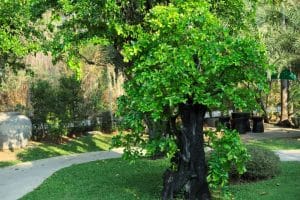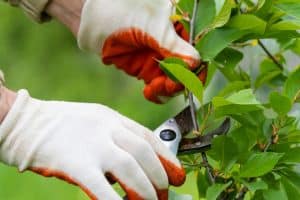Ever peek out your window and see your neighbour’s tree looking all fancy and sculpted like it just stepped off a magazine cover? Well, guess what? It’s not just about having fancy pruning shears (though sharp tools do help!). The real trick is knowing how to snip for each kind of tree. Just like humans, different trees need unique pruning techniques, and the way you prune them can totally transform how they look and feel.
So, when’s the best time to prune those branches?
Just like you wouldn’t chop your hair off right before a beach trip, trees have their own preferred times for a prune. Most are happy to take a nap between late autumn and early spring. Think of it as giving them some downtime to heal up those snips before they have to gear up for showing off all their new leaves in spring.
However, some of your flowering friends are a bit different. They like a quick tidy-up after they’ve finished putting on a flower show. This keeps them blooming their best year after year.
Do different pruning techniques vary by tree type?
Absolutely! Here’s a quick guide to some common methods and the tree types that love them:
- Crown thinning: Think of this as giving your tree a good hairbrush. It’s like brushing out all the wispy bits to let in more light and air, keeping your tree strong and healthy. Works great for grown-up trees like oaks and maples.
- Deadwooding: This one’s a no-brainer for all trees. It’s basically cleaning out the dead, diseased, or broken branches to prevent the spread of nasties and encourage healthy growth.
- Crown raising: Need to give those pesky low branches the flick for more under-tree clearance? Crown raising removes lower branches to create a higher canopy. Great for trees planted near walkways, driveways, or power lines. Think crepe myrtles or liquidambars.
- Crown reduction: Got a giant looming a little too close to your house? Crown reduction involves shortening larger branches to keep the tree in check. This one’s best left to the pros for species like Jacarandas or Poincianas, as improper technique can do more harm than good.
- Pollarding: This is a more drastic approach where branches are repeatedly cut back to a stub every few years. It creates that distinctive lollipop shape and is typically used for specific purposes like street trees or hedges. Not all trees are fans though, so be sure to check if it’s suitable.
How to identify the best pruning techniques for your tree
While these techniques are handy, remember that trees are individuals too! Here’s how to pick the perfect snip for your specific leafy mate:
- Age matters: Young whippersnappers might benefit from some formative pruning to build a strong structure, while older trees might just need a bit of thinning to stay healthy.
- What’s the goal? Do you want a tree overflowing with juicy mangoes, a cloud of pink blossoms, or just some lovely shade? Picking the right pruning technique depends on what you want to achieve.
- Tree TLC: Pruning can also be a health check-up for your tree. Removing dead, diseased, or damaged branches helps keep them fighting fit and prevents the spread of nasties.
Safety precautions and techniques for proper pruning
Alright, listen up. Tree pruning can be a blast, but gotta make sure it’s safe for you and your leafy friend. Here’s how to avoid any ouchies and keep things chill:
- Gear up: Ditch the kitchen scissors! Invest in some sharp secateurs and loppers. For those real chonky branches, a pruning saw might be your new best friend.
- Clean cuts, happy tree: Imagine giving your tree a neat haircut. That’s the vibe! Always cut branches just above a bud or that little bump where it meets the main branch (the branch collar), using a sawing motion. No hacking away!
- Slow and steady wins the race: Don’t get carried away, especially with big branches. Take your time, make smaller cuts, and don’t try to be Rambo with a saw. Remember, you can always take more off, but you can’t put it back on!
- Know your limits: Feeling like a superhero with newfound tree-climbing skills? Hold your horses! Don’t attempt cuts on branches that are way out of reach or make you feel wobbly. For those high-up jobs, calling in the pros with training on performing pruning procedures ensures a safe and effective job.
When to call a professional: Recognising situations beyond DIY pruning
You can totally tackle some pruning yourself, but for some jobs, it’s best to call in the big guns. Here’s when to bring in the pros:
- Sickly or wonky trees: Feeling like your tree needs a doctor? It probably does! If your leafy friend looks sick or wonky, an expert can give it the right kind of trim to get it back on track.
- Species with specific needs: Certain trees, like fruit trees, benefit from the expertise of an arborist to ensure optimal results.
- Big and beautiful (or Intimidating): Extensive pruning on large or mature trees can be dangerous and requires specialised equipment. Leave the tree pruning to the experts with all the fancy tools. They’ll make sure your tree stays happy and healthy.
The takeaways
There you have it! Now you know enough to keep your tree buddies happy with some smart snipping. Remember, pruning isn’t about going with the shears – it’s like giving your trees a high five to help them grow up big and strong. So grab your snippers (carefully!), pick the right move for your tree, and get to it!
The Yard: Your partner in happy trees
Feeling a bit out of your depth or simply short on time? No worries! The Yard is here to help. Our awesome arborists are here to assist with anything tree-related. Need advice on the best way to prune your prized possession? We got you. Branches gone rogue and way outta reach? We’ve got the gear, the know-how, and most importantly, the tree love to get things back in shape. Contact us today and let’s chat about how to make your yard the envy of the block!



